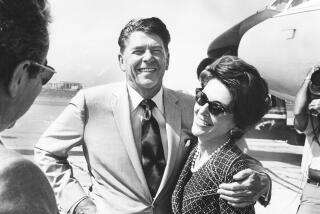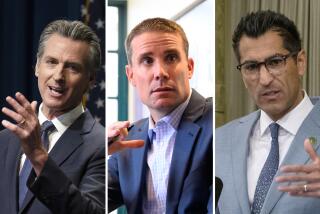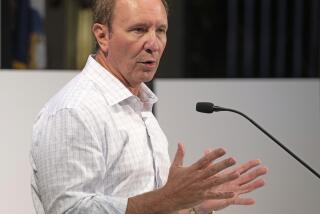The Candidates and How They Govern
AUSTIN, Texas — Soon after George W. Bush was first inaugurated as Texas’ governor in 1995, he invited Paul Sadler to his office for lunch. Both men had reason to feel wary.
Sadler, a shrewd young Democratic state representative from a small town in East Texas, had campaigned actively the previous fall for Democratic Gov. Ann Richards, who Bush unseated in the 1994 election. As an expert on education, Sadler often had made the Democratic case on school reform at events where Bush also appeared.
But when they met in 1995, Bush put Sadler at ease even before they opened their box lunch sandwiches. The new governor thanked the Democrat for avoiding partisan attacks during the campaign appearances. Then, over lunch, the two men chewed over each other’s ideas for reforming the state’s schools, an agenda that would dominate much of Bush’s tenure as governor.
That meeting marked the start of an unusually productive relationship between Bush and Sadler, chairman of the Texas state House Committee on Public Education. More important, the session offered an early signal of how Bush would try to advance his goals as governor--and would likely try to operate as president if elected this fall.
In Texas, the keys to Bush’s governing style have been personal relationships, bipartisanship, a willingness to compromise and a determined effort to set the political agenda, even while ceding to legislators unusual freedom to fill in the details.
With this simultaneously intimate and detached approach, Bush has enjoyed great success at moving his priorities through a state legislature where power is narrowly divided between the two parties--the same precarious environment the next president is likely to face in Congress. In the process, Bush has proven himself not only amiable but flexible: Central to his success has been a willingness--on virtually every major issue--to make substantive compromises to build bipartisan coalitions.
“To the extent people want to work together, and want to seek solutions, he can build consensus,” Sadler says.
Yet Bush’s highly personal, largely nonconfrontational style also contributed to the defeat of his most ambitious proposal as governor: a sweeping rewrite of the state tax code that failed in 1997 when Republicans in the state Senate rebelled against it. That episode raises pointed questions about Bush’s capacity to shape the dialogue on an issue where, despite his best efforts, the two parties polarize on ideological lines--a situation far more common in Washington than in Austin.
Building Consensus
The Texas governorship is often described as “weak,” and the office does lack some of the powers--particularly making appointments--common elsewhere. But the governor enjoys enormous leverage to shape the priorities for the state Legislature, which meets for only one 140-day session every two years and thus lacks the time and capacity to build sustained support for any competing agenda.
“I hear people say the governorship of Texas is weak, but it always comes from academia and the media,” Sadler says. “I don’t ever hear members of the Legislature say that. I have yet to see a governor who did not control the agenda.”
From the outset, Bush’s efforts at such control have rested on several distinct approaches. At the top of the list has been a determination to build personal relationships with lawmakers in both parties. Even before Bush was inaugurated in 1995, one Austin lobbyist remembers him systematically shaking hands from table to table at an annual dinner held by the wives of state senators; the year before, Richards had remained, somewhat regally, in her seat the entire evening.
That was a tip-off to their contrasting styles. While the tart-tongued Richards was a national media celebrity, many lawmakers found her remote and overly partisan. Bush benefited from the comparison; many legislators say they found him accessible, unpretentious and a good listener.
“[Richards] was aloof and the big star, while everyone else was the grunts,” says Steve Bresnen, the general counsel for former Democratic Texas Lt. Gov. Bob Bullock. “Bush came in and he treated everybody like they counted, and he listened to them. It doesn’t have a great deal of majesty when you describe it that way, but it worked, and that’s what we needed.”
Bush’s relationship with Bullock, who died of cancer last year, both typified and marked the greatest success of his approach. The lieutenant governor exerts enormous control over the state Senate, and the irascible Bullock was generally considered the state’s most powerful politician when Bush was first elected.
Though Bullock was a Democrat and 17 years his senior, Bush began courting him even before his election--visiting his home twice before he defeated Richards, recalled his widow, Jan Bullock. The first time, the two men spent several hours sitting at the family’s kitchen table. “Bob doesn’t pass out compliments easily; nothing or nobody impressed him . . . and especially because [Bush] was the son of a president and had never been in an elected position, Bob was leery,” said Jan Bullock. “But when he left Bob said, ‘I really like him. He’s got his head in the right place.’ ”
Once Bush took office, the relationship deepened into an extraordinary partnership, with Bullock (who eventually endorsed Bush for reelection in 1998) corralling critical Democratic support for the governor’s key initiatives and serving as a legislative mentor. Bresnen recalled Bush routinely showing up unannounced in Bullock’s office to discuss legislative strategy or just shoot the breeze--something Richards rarely did.
“It was the willingness to just show up and act like a normal human being would act with another human being that was so striking,” says Bresnen, who now lobbies for liberal groups in Austin.
Bullock was a tempestuous personality, prone to eruptions of anger and fond of legislative arm-twisting. Bush almost always avoided such confrontations.
At times, Bush could “really dress somebody down” who was resisting his ideas, says Republican state Sen. Bill Ratliff, chairman of the Senate Finance Committee. But several lawmakers in both parties say they have never heard Bush issue a flat-out ultimatum in negotiations--threatening to veto an entire bill if a provision was not written to his liking.
“Bush is not Lyndon Johnson-esque: He doesn’t break arms; he doesn’t overpower people,” says veteran Austin lobbyist Bill Miller. “If you are going to get there through vinegar or honey, he’s always going the honey route.”
In each of his three Texas legislative sessions, Bush has presented a relatively focused list of priorities and concentrated his attention on those issues--such as welfare, education and juvenile justice reform in his first session, tax reform in his second and ending social promotion in public schools in 1999.
Once Bush established those goals, he gave the Legislature enormous freedom to fill in the particulars. Often he relied on his staff to handle the most detailed talks. “He has people he trusts, and he’s like the captain of the ship: He’ll ask for the weather report, but he’s not actually going to try to predict the weather himself,” said state Sen. David Sibley, a GOP leader.
Yet legislative leaders in both parties say it’s a mistake to view Bush as an above-the-fray chief executive. On his main issues, he has worked aggressively to broker agreements. Sometimes that’s meant intense personal negotiations with key legislators.
Just as often, while laying out his own preferences, Bush positioned himself almost as a bridge between contending legislative factions. “Most of the time, he calls in two or three [legislators] from each side and gets them to talk to each other, with him inserting comments or expressing opinions in some cases,” Ratliff says. “It is almost a moderator or mediator role, but a mediator with strong opinions where the limits are.”
This approach has worked for Bush partly because he’s built personal trust with lawmakers. But equally important has been a willingness to move his feet; though he almost always starts from a center-right position, Bush on most key issues has given enough ground to broaden Democratic support for his ideas.
In his first session, Bush accepted significant compromises on all of his four priorities: juvenile justice, welfare reform, a rewrite of the state education code and legislation to limit lawsuits against business. In his second session, he publicly supported Sadler and House Democrats as they significantly rewrote his tax reform plan. In the 1999 session, he accepted a tax cut significantly smaller than he originally proposed, more spending on education than he originally offered and safeguards sought by legislators for students who otherwise might had been forced to repeat a grade under his plan to end social promotion in the schools.
“The governor is a big-picture guy,” says Democratic state Rep. Robert Junell, chairman of the House Appropriations Committee. “Does he know the details? Yes. But is he willing to negotiate on the details? Absolutely.”
The final element of Bush’s strategy has been a ruthless discipline in picking his fights. As he focuses on his own priorities, he has been unusually determined to avoid entanglements on other issues. That’s led some activists in both parties to accuse him of trying to duck controversial issues with the potential to divide his political coalition.
In 1999, for instance, Democrats denounced Bush when he failed to intervene to break a deadlock in the state Senate that killed a proposed hate crimes statute.
Similarly, Bush in the wake of the 1999 shootings at Columbine High School in Colorado expressed support for an instant background check on purchases at gun shows--but only hours after a state House committee had voted down a bill to require them. Democratic state Rep. Debra Danburg, the bill’s principal sponsor, tried to enlist Bush’s help in reviving the measure. But Bush remained on the sidelines as the bill died.
“Bush’s style is he will have . . . a crafted message, he will have it styled in a way for general consumption that is very effective and he won’t comment on anything else,” charges Danburg. “You can ask him about anything in the world, and he’s a political handler’s dream: He will get back within three words to the message they have polled on.”
Notwithstanding such complaints, Bush’s legislative strategy--what might be called focus and flexibility--has generally served him well, most analysts agree. Yet his record also shows the potential limitations in this approach.
His most dramatic failure as governor came on his most ambitious proposal, the state initiative most comparable in sweep and complexity to his presidential campaign calls to partially privatize Social Security and slash income tax rates. Bush’s 1997 state tax reform plan failed largely because powerful forces in the business community arrayed against it. But Bush’s reluctance (or inability) to steer the legislative process more forcefully may also have contributed to the debacle.
His plan lacked nothing in scale: He sought to cut state property taxes by $3 billion annually while increasing sales taxes and imposing a new tax on business to offset the revenue loss for local school districts. The plan had three ambitious goals: to ease the burden of rising property tax bills on homeowners; to provide more equity in funding between rich and poor school districts; and to shift the burden of business taxation from capital-intensive industries (such as refineries) toward other forms of business, particularly partnerships such as law firms.
Bush hatched the plan’s details with unusual secrecy--to the point where he had his budget office buy its own software to analyze the proposal so that he wouldn’t be dependent on numbers from the state comptroller, a Democrat.
That secrecy cost Bush: When he unveiled the plan, few legislators rallied to it. Yet as opposition mounted, Bush pressed on; he told friends the purpose of political popularity was precisely to make possible this sort of far-reaching reform.
With Bush’s plan foundering, the House turned to a special panel, chaired by Sadler, to rewrite it. Sadler sweepingly reconstructed the plan--moving it in a more Democratic direction by increasing the taxes on business and shifting more of the overall burden for education funding from local governments to the state. Though many Republicans grew restive, Bush staunchly backed Sadler.
Yet when the plan moved to the state Senate, Bush frustrated Sadler and other Democrats by remaining silent as conservatives radically retrenched the proposal to reduce levies on business. Bush told Sadler his goal was simply to get any plan out of the Senate so that the differences could be resolved in a conference committee. But Sadler warned Bush that the differences between the chambers were widening to a point where no agreement might be possible.
In the end, that’s exactly what happened. Eventually Bush was forced to pronounce the plan dead and accept only a $1-billion cut in property taxes funded out of the state budget surplus.
Some observers see in this story the potential flaw in Bush’s light-on-the-reins legislative style: By remaining relatively passive while the House and Senate moved in disparate directions, he allowed an insurmountable gap to emerge. Others say Bush failed simply because he was ahead of his time in taking on the property tax issue before a crisis demanded action. Strikingly, even after the turbulent battle, legislators in both parties gave him high praise for setting a constructive tone.
“Throughout the entire ordeal, he was never negative toward us, he kept the debate on a very high plane and he continually tried to move it forward so we could all be successful,” Sadler says. “That is an incredible model for dealing with people and a legislature, and totally unlike what you see in Washington.”
Will His Style Work in Washington?
Which raises the question of whether the style Bush has employed in Texas could work in Washington. Most observers agree he’s had advantages in his home state that wouldn’t apply in the nation’s capital. Most important, in Texas Bush was operating in an environment with a tradition of bipartisan cooperation.
Many observers say Bush faced his biggest problems with fellow Republicans who disliked his willingness to make compromises that blurred the party differences. “Some of our Republicans are much less inclined to compromise than he is,” Ratliff says.
That problem could be far more acute for Bush in Washington, where many conservatives (like their liberal counterparts) have come to view the legislative session less as a way of passing laws than as an opportunity for framing the next election around stark disagreements.
Another question is whether Bush’s desire to maintain strong personal relationships with lawmakers will inhibit his ability to use one of a president’s most powerful weapons: the bully pulpit. Bruce Buchanan, a University of Texas government professor, notes that, because Bush puts such a premium on good personal ties with lawmakers, he was reluctant to try to mobilize public opinion against them. “He wants to maintain a certain cordiality,” Buchanan says, “and that kind of ties his hands.”
A third factor may complicate Bush’s hopes of repeating his bipartisan pattern: his own agenda. Compared with the ideas he pushed as governor, Bush’s presidential agenda--a sweeping cut in income tax rates, missile defense, partial privatization of Social Security--has more limited appeal to Democrats.
Yet Texas legislators who have worked with Bush express considerable optimism that his approach could work in the White House. “Let me tell you what I see as the model,” says Sibley. “In the 1950s you had [Democrats] Lyndon Johnson as Senate minority leader and Sam Rayburn as House speaker, working very closely with President Eisenhower [a Republican]. I think you’ll see something like that: an era of goodwill.”
He adds: “I think you’ll see Bush . . . definitely trying to put together a coalition of moderate Democrats who will work with him. Here’s my prediction: You will see hard-line, hard-core Republicans hollering as much as hard-core Democrats.”
More to Read
Get the L.A. Times Politics newsletter
Deeply reported insights into legislation, politics and policy from Sacramento, Washington and beyond. In your inbox three times per week.
You may occasionally receive promotional content from the Los Angeles Times.










